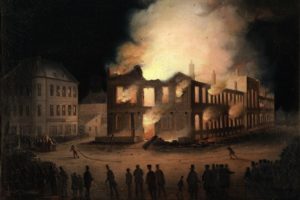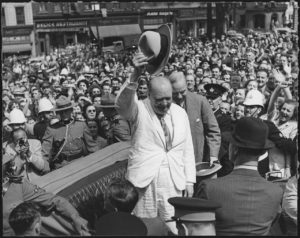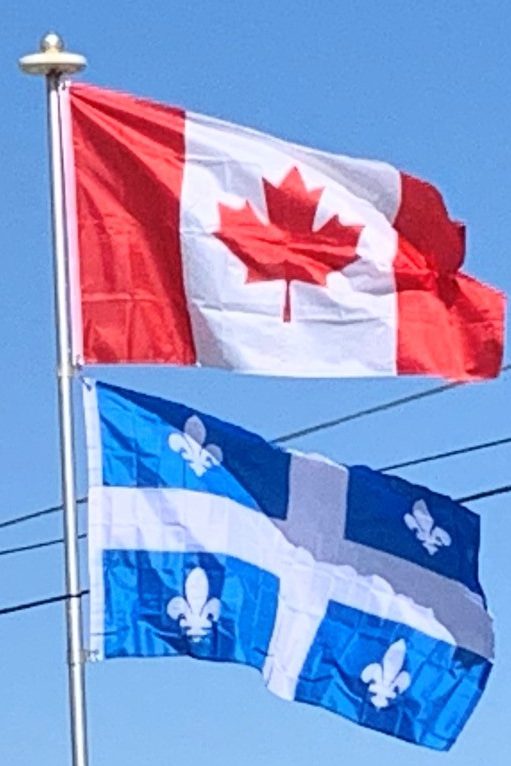
In 1848, Baldwin and LaFontaine, allies and leaders of the Reformist party, were asked by Lord Elgin to form an administration together under the new policy of responsible government. The French language subsequently regained legal status in the Legislature.
Canadian Confederation:
In the 1860s, the delegates from the colonies of British North America (Canada, New Brunswick, Nova Scotia, Prince Edward Island, and Newfoundland) met in a series of conferences to discuss self-governing status for a new confederation. The first Charlottetown Conference took place in Charlottetown, Prince Edward Island, followed by the Quebec Conference in Quebec City which led to a delegation going to London, England, to put forth a proposal for a national union.
As a result of those deliberations, in 1867 the Parliament of the United Kingdom passed the British North America Acts, providing for the Confederation of most of these provinces. The former Province of Canada was divided into its two previous parts as the provinces of Ontario (Upper Canada) and Quebec (Lower Canada). New Brunswick and Nova Scotia joined Ontario and Quebec in the new Dominion of Canada. The other provinces then joined the Confederation, one after the other: Manitoba and the Northwest Territories in 1870, British Columbia in 1871, Prince Edward Island in 1873, Yukon in 1898, Alberta and Saskatchewan in 1905, Newfoundland in 1949 and finally Nunavut in 1999.
World War I and World War II:
When Great Britain declared war on August 4, 1914, Canada was automatically involved as a dominion. About 6,000 volunteers from Quebec participated on the European front. Although reaction to conscription was favourable in English Canada the idea was deeply unpopular in Quebec. The Conscription Crisis of 1917 did much to highlight the divisions between French and English-speaking Canadians in Canada.

During World War II, the participation of Quebec was more important but led to the Conscription Crisis of 1944 and opposition. Many Quebecers fought against the axis power between 1939 to 1945 with the involvement of many francophone regiments such as Les Fusiliers Mont-Royal, le Régiment de la Chaudière and many more.
Quiet Revolution:
The conservative government of Maurice Duplessis and his Union Nationale dominated Quebec politics from 1944 to 1959 with the support of the Catholic Church. Pierre Trudeau and other liberals formed an intellectual opposition to Duplessis’s regime, setting the groundwork for the Quiet Revolution under Jean Lesage’s Liberals. The Quiet Revolution was a period of dramatic social and political change that saw the decline of Anglo supremacy in the Quebec economy, the decline of the Roman Catholic Church’s influence, the formation of hydroelectric companies under Hydro-Québec and the emergence of a pro-sovereignty movement under former Liberal minister René Lévesque.

October Crisis:
Beginning in 1963, a paramilitary group that became known as the Front de libération du Québec (FLQ) launched a decade-long program of propaganda and terrorism that included bombings, robberies and attacks directed primarily at English institutions, resulting in at least five deaths. In 1970, their activities culminated in events referred to as the October Crisis when James Cross, the British trade commissioner to Canada, was kidnapped along with Pierre Laporte, a provincial minister and Vice-Premier. Laporte was strangled with his own rosary beads a few days later. In their published Manifesto, the militants stated: “In the coming year Bourassa will have to face reality; 100,000 revolutionary workers, armed and organized.” At the request of Premier Robert Bourassa, Prime Minister Pierre Trudeau invoked the War Measures Act.
Parti Québécois and National Unity:
In 1977, the newly elected Parti Québécois government of René Lévesque introduced the Charter of the French Language. Often known as Bill 101, it defined French as the only official language of Quebec in areas of provincial jurisdiction.
